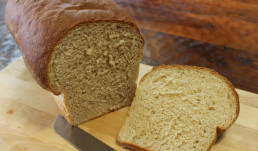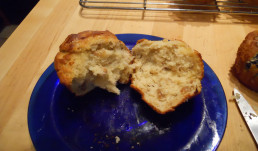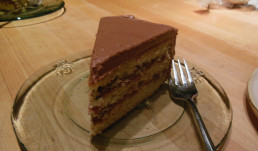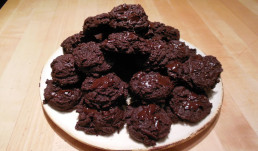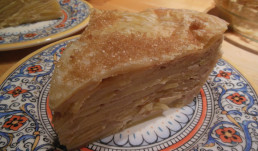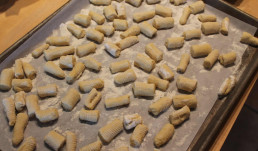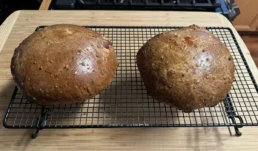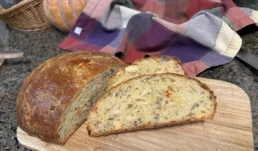adapted from the Washington Post
For the filling:
- 8 ounces (227 grams) mild or sweet Italian sausage, removed from casing
- 200 grams diced Pecorino Romano
- 3 leeks (10 ounces/283 grams), diced
- 1/2 teaspoon fine salt
- 1 tablespoon olive oil (optional, if needed)
For the dough:
- 4 cups (500 grams) all-purpose flour, plus more for dusting
- 2 tablespoons granulated sugar
- One (1/4-ounce/7-gram) package instant yeast (2 1/4 teaspoons)
- 2 teaspoons herbes de Provence
- 3/4 teaspoon fine salt
- 3/4 cup (180 milliliters) water
- 1/4 cup (60 milliliters) extra-virgin olive oil, plus more as needed
- 4 large eggs, divided
Make the filling: In a medium or large skillet over medium-high heat, add the sausage and cook, stirring and breaking the meat into small pieces with a spoon or spatula, until no longer pink, about 5 minutes. Using a slotted spoon, transfer the meat to a medium bowl, leaving the rendered fat in the skillet.
Add the leeks and salt to the skillet and cook, stirring occasionally, until they start to soften, about 8 minutes. (If your sausage didn’t render much fat and the leek starts sticking to the skillet, add the olive oil.) Add the leeks to the sausage and stir to combine; set aside to cool until needed. Dice cheese and set aside separately.
Make the dough and bread: In the bowl of a stand mixer fitted with a dough hook attachment — or using a large bowl, if mixing by hand — stir together the flour, sugar, yeast, herbes de Provence and salt until combined.
In a large glass measuring cup, microwave the water for 30 to 60 seconds, until it reaches a temperature between 120 and 130 degrees. Add the olive oil and 3 of the eggs, and whisk to combine.
Turn the mixer on low speed and slowly pour in the egg mixture. Increase the speed to medium-low and knead for 3 to 4 minutes, until the dough is uniform and sticky. (If mixing by hand, stir with a wooden spoon or hand mixer with dough hooks until the dough comes together and is uniform and sticky, about 4 minutes.)
Lightly flour your work surface and scrape the dough onto it. Adding about a quarter of the sausage and cheese mixtures at a time, knead the dough, dusting with more flour as needed, until all of the sausage mixture and cheese are incorporated and evenly combined. (The dough will be quite sticky, so a bench scraper is a great tool to help with folding the dough over itself.) Don’t fret if it looks a little messy — that’s how it’s supposed to be.
Lightly grease a large bowl with olive oil. Transfer the dough to the greased bowl, gently turn it to coat it lightly on all sides with oil, cover tightly with plastic wrap or a large plate, and let it rise until it has approximately doubled in size, 45 to 60 minutes.
Line a large sheet pan with parchment paper and lightly flour your work surface. When the dough is ready, gently punch it down and transfer to the prepared surface. Divide in half – each should weigh about 715 grams – and shape each into a ball. Transfer to the prepared sheet pan with at least 2 inches of space between the loaves. (You may need to position them diagonally to allow for enough space.) Cover with plastic wrap or a kitchen towel and let rise again for 30 minutes.
While the loaves are rising, position a rack in the middle of the oven and preheat to 350°F.
In a small bowl, beat the remaining egg until combined, and brush over the loaves. Bake for 45 minutes, rotating the pan front to back halfway through, or until nicely browned and the internal temperature of the loaves registers at least 190°F. Let cool on the sheet pan set atop a wire rack for at least 15 minutes before slicing and serving.
- 2-Day Rise Pizza Dough
- A Wholesome Loaf
- Aleppo Tomato Bread
- Anjero
- Bacon and Tomato Swirl
- Bagels
- Barmbrack
- Basic White Bread
- Boule
- Braided French-Style Bread
- Breadsticks
- Brioche Dough
- Buttermilk Bulgur Bread
- Cheddar Beer Bread Rolls
- Chocolate Bread
- Ciabatta
- Cinnamon-Raisin Swirl Bread
- Crusty French Rolls
- Crusty Italian Bread
- Crusty Italian Sourdough
- Danish Pastries
- Dinner Rolls
- Double Wheat Whole Wheat Bread
- Dutch Crunch Rolls
- Five Grain Bread with Walnuts
- Focaccia
- Focaccia
- Focaccia Genovese
- Focaccia Ragusata
- Grandmother’s Dinner Rolls
- Guinness Rye Bread
- Hamburger Buns
- Hamburger Buns
- Hamburger Buns
- Honey Corn Rolls
- Hot Cross Buns
- Irish Country Bread
- Italian Easter Bread (Pinza)
- James Beard Basic White Bread
- James Beard Single Rise Loaf
- James Beard’s French-Style Bread
- Japanese-Style White Bread
- Kanelsnurror
- Knotted Dinner Rolls
- Kolaches
- Kosovo Pitalke
- Medieval Bread
- Milk Bread
- Molasses Oatmeal Bread
- Multi Grain Sandwich Bread
- Multi-Grain Seeded Bread
- No Knead Artisan Bread
- No-Knead Walnut Raisin Bread
- No-Knead White Bread
- Oma’s Christmas Stollen
- Onion Poppy Seed Bread
- Pain Francais
- Pan Rustico – Rustic Spanish Bread
- Pane al Pistacchio
- Pane all’Olio
- Pane Bianco
- Pane di Como Antico
- Pane Pugliese
- Pane Siciliano
- Panettone
- Panini con erbe aromatiche
- Pecorino Cheese Bread
- Pepper Bread
- Pepper Bread
- Pistachio Onion Bread
- Pistachio, Onion, and Cheese Bread
- Pistolet
- Pita
- Pogaca Rolls
- Pumpkin Rolls
- Russian Black Bread
- Rustic Bread
- Rustic Potato Bread
- Rustic Red Fife Bread Flour
- Rye Berry Rye Bread
- Rye Bread
- San Francisco-Style Sourdough
- Sausage, Pecorino, and Leek Bread
- Semelle
- Soft Pretzels
- Sourdough Country Bread
- Taboun Flatbread
- Tartine’s Sourdough Bread
- Tomato Bread
- Walnut Raisin Bread
- Walnut Raisin Bread
- Walnut Raisin Sourdough Bread
- Whole Wheat Buttermilk Bread
- Wisconsin Spicy Cheese Bread
- Zupfe Loaf with Asiago, Parmesan, and Romano


